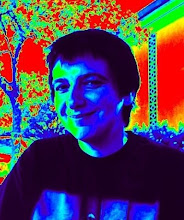
Childhood is a miserable state of captivity, which by an enormous dilation of perceptive time seems to last an eternity, even though it merely occupies a small fraction of a person's life. We humans spend a good deal of our life trying to escape the grasp of childhood and the rest trying to fend off the coming of old age. What is left in between we call living.
It is difficult to place memories in early childhood. Mostly they are reconstructed memories from later hearsay of adult witnesses, colored by adult interpretation. One can focus at least on objects that impressed a memory of themselves early on. I probably have to get to about the time when I was already between two and three years old to locate some of them.
Three years old is a good demarcation point, since that's when I started going to preschool, hence to meet other human beings of my same type (other fellow captives of the childhood shackles). Before I was alone in a world of grownups who exerted complete control over my every mode of existence.
So I will use this first landmark and talk about a before and an after. There will be many other before and afters, many other gates and passageways that separate chambers of existence. Tight sealed doors opening up at determined times and just so briefly as to let a person through. They mark the one way steps in the ascent towards adulthood.
In that first before I remember learning how to read. I was the only one who already could read in the first year of preschool. My mother taught me, with that method by which you recognize words as a whole and learn later to break them down into individual letters. I always thought I owe it to that if I can read so fast, by just taking in words without having to assemble them out of any finer structure. By comparison, with the other alphabets I learned later in life, such as Greek or Cyrillic, I had to re-learn reading in a more traditional "letters first" manner, and, even at times when I was reading in these alphabets frequently, I never managed to read as fast as with the "words first" method. On the other hand, I am totally helpless at the kind of game like saying words in reverse, as, even for simple words, I cannot build in my mind an image of them as composed of an ordered set of letters, let along read these letters one by one in the opposite direction. For much the same reason, I am very bad at telling aloud the spelling of a word, or reconstructing a word when I hear its spelling, even though I generally make very few spelling mistakes when writing.

Learning how to write wasn't as easy. I had to be told repeatedly that the left to right direction matters and that the method I was following, getting to the end of the line and starting the next line in the opposite direction, was not allowed. I much later learned how to read ancient Greek inscriptions and then I also learned the term "boustrophedonic", denoting precisely the habit of writing alternating lines from left to right and from right to left (literally, in the way the oxes drag the plough in successive furrows). This method of writing was widely used in the archaic Greek period, as well as by the Etruscan and the early Roman. It is known in Babylon and in several other ancient cultures. I wish I had known at the time when my preschool teacher yelled at me for spoiling the piece of paper she gave me with my absurd way of writing. So short is the collective memory of civilization. So close are our early individual steps into the world to the ones we collectively took as a species just a few thousands of years ago.

A beautiful toy I remember from that same before was one my parents must have found in some strange producer of psychological and cognitive tests and wasn't meant at all as a toy for pre-preschool children, but never mind that. I loved it. It was a large brown carton box containing a number of plastic objects in different shapes and colors. They came in three shapes: triangle, square, and circle; in three colors: red, yellow, and blue; in three sizes: large, medium, small; and in three levels of thickness. You get the point: it was about set theory. Group together all the things that are yellow and large but not very thick, those that are circles but not blue, and so on. I spent hours with that beautiful toy, thinking up all possible and/or/not combinations I could come up with. I guess that was my first glimpse into the mathematical mind.

